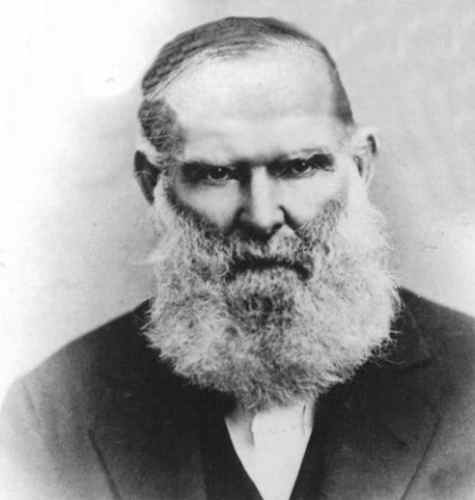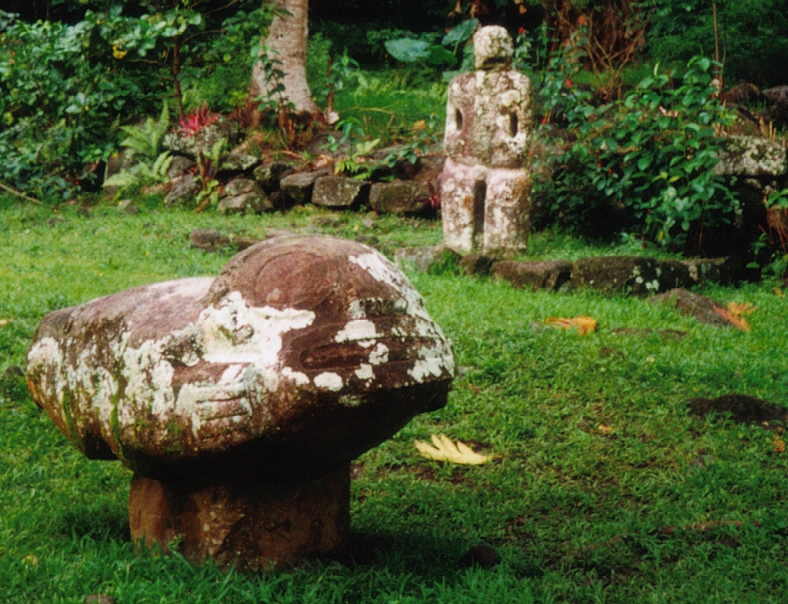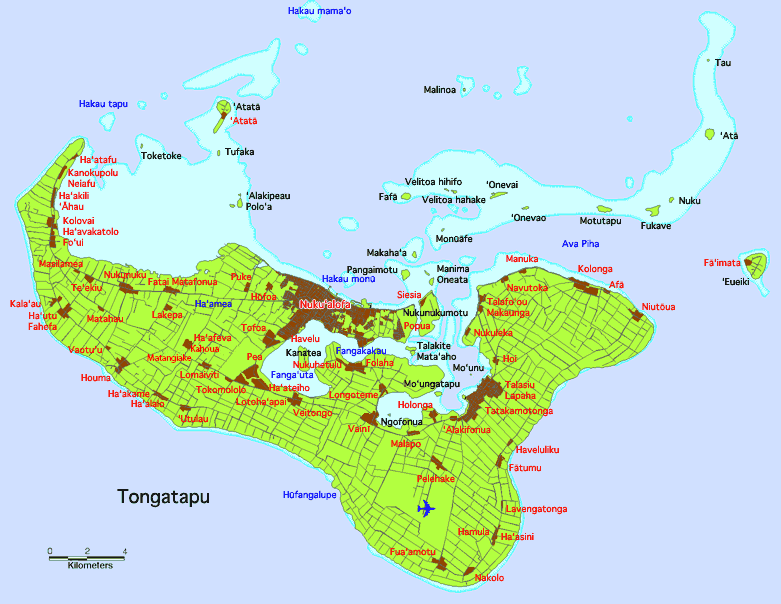|
Laufakana'a
In the Polynesian mythology of Tonga, Laufakanaa (speak to silence; i.e.: command he windsto calm down) was a primordial creator god his home was Ata. In Tongan cosmogony, the sky and the sea, and the land of Pulotu (the dark underworld, the home of the souls of departed chiefs) existed from the earliest times. All other lands were created later. Either they were thrown down from the sky by Havea Hikuleo or, subsequently, they were fished up by Maui from the bottom of the ocean. All the ''makafonua'' (landstones) of Hikuleo were full of unevenness, and tended to jump around (that is, they were the source of earthquakes) and were full of holes and pits (that is, volcanoes), while Maui's lands were smooth (coral islands and atolls). ʻAta and ʻEua, the islands which were fished up first, were quite hilly, as Maui apparently was not an expert fisherman yet. His next catch, (Tongatapu) he kept much smoother. The first people of Ata came forth directly from the same ''uanga'' (fly ... [...More Info...] [...Related Items...] OR: [Wikipedia] [Google] [Baidu] |
ʻAta
Ata is a depopulated island in the far southern end of the Tonga archipelago, situated approximately south-southwest of Tongatapu. It is distinct from Atā, an uninhabited, low coral island in the string of small atolls along the Piha passage along the north side of Tongatapu. An unrelated traditional chiefly title from Kolovai is "Ata". Although superficially spelled in similar ways, Ata means ''reflection'' in Tongan; Ata means ''dawn'' and is the title of a chief; and Atā means more room or expanding. Myths Although Ata must have been known to Tongans from times immemorial, as it features in old myths, it may have been confused with Atā, and it is alleged not to have been remembered until the Tongans were told about it by the Europeans. According to Tongan myths it was, together with Eua, the first island hauled up by the Maui brothers from the bottom of the sea. It originally had seven hills, but Maui stamped on the highest mountain until it was flattened into its s ... [...More Info...] [...Related Items...] OR: [Wikipedia] [Google] [Baidu] |
Tamapo'uli'alamafoa
In the Polynesian mythology of the Tongan island of ʻAta, the god Tamapoulialamafoa is the king of the heavens. He is the one who ordered (through his servants all called Tangaloa Tangaloa was an important family of gods in Tongan mythology. The first Tangaloa was the cousin of Havea Hikuleo and Maui, or in some sources the brother or son or father of them. He was Tangaloa Eiki (''T. lord''), and was assigned by his father, ... (Tangaloa Eiki, Tangaloa Tufunga, and Tangaloa Atulongolongo)) the sub-god Laufakanaa to become ruler of that island. According to others, however, Tangaloa Eiki was the ancestor god and Tangaloa Tamapoulialamafoa, Tangaloa Eitumātupua, Tangaloa Atulongolongo, and Tangaloa Tufunga his offspring. Notes References *O. Māhina, ''Ko e Ngaahi Ata mei he Histōlia mo e Kalatua o Tongá: Ke Tufungai ha Lea Tonga Fakaako'', AU 2006, {{ISBN, 978-0-908959-09-9 Tongan deities ... [...More Info...] [...Related Items...] OR: [Wikipedia] [Google] [Baidu] |
Polynesian Narrative
The Polynesian narrative or Polynesian mythology encompasses the oral traditions of the people of Polynesia (a grouping of Central and South Pacific Ocean island archipelagos in the Polynesian Triangle) together with those of the scattered cultures known as the Polynesian outliers. Polynesians speak languages that descend from a language reconstructed as Proto-Polynesian - probably spoken in the Tonga - Samoa area around 1000 BC. Description Prior to the 15th century AD, Polynesian peoples fanned out to the east, to the Cook Islands, and from there to other groups such as Tahiti and the Marquesas. Their descendants later discovered the islands from Tahiti to Rapa Nui, and later Hawai‘i and New Zealand. The latest research puts the settlement of New Zealand at about 1300 AD. The various Polynesian languages are all part of the Austronesian language family. Many are close enough in terms of vocabulary and grammar to permit communication between some other language speakers ... [...More Info...] [...Related Items...] OR: [Wikipedia] [Google] [Baidu] |
Yam (vegetable)
Yam is the common name for some plant species in the genus '' Dioscorea'' (family Dioscoreaceae) that form edible tubers. Yams are perennial herbaceous vines cultivated for the consumption of their starchy tubers in many temperate and tropical regions, especially in West Africa, South America and the Caribbean, Asia, and Oceania. The tubers themselves, also called "yams", come in a variety of forms owing to numerous cultivars and related species. Yams were independently domesticated on three different continents: Africa (''Dioscorea rotundata''), Asia (''Dioscorea alata''), and the Americas (''Dioscorea trifida''). Etymology The name "yam" appears to derive from Portuguese ''inhame'' or Canarian (Spain) ''ñame'', which derived from West African languages during trade. However in both languages, this name commonly refers to the taro plant (''Colocasia esculenta'') from the genus ''Colocasia'', as opposed to '' Dioscorea''. The main derivations borrow from verbs me ... [...More Info...] [...Related Items...] OR: [Wikipedia] [Google] [Baidu] |
Ti (plant)
''Cordyline fruticosa'' is an evergreen flowering plant in the family Asparagaceae. The plant is of great cultural importance to the traditional animistic religions of Austronesian people, Austronesian and Papuan people, Papuan peoples of the Pacific Islands, New Zealand, Island Southeast Asia, and Papua New Guinea. It is also cultivated for food, traditional medicine, and as an ornamental for its variously colored leaves. It is identified by a wide variety of common names, including ti plant, palm lily, cabbage palm. Description Ti is a palm-like plant growing up to tall with an attractive fan-like and spirally arranged cluster of broadly elongated leaves at the tip of the slender trunk. The leaves range from red to green and variegated forms. It is a woody plant with leaves (rarely ) long and wide at the top of a woody stem. It produces long panicles of small scented yellowish to red flowers that mature into red berry (botany), berries. Taxonomy ''Cordyline fruticosa'' ... [...More Info...] [...Related Items...] OR: [Wikipedia] [Google] [Baidu] |
Plantain (cooking)
Cooking bananas are banana cultivars in the genus ''Musa'' whose fruits are generally used in cooking. They may be eaten ripe or unripe and are generally starchy. Many cooking bananas are referred to as plantains (/ˈplæntɪn/, /plænˈteɪn/, /ˈplɑːntɪn/) or green bananas. In botanical usage, the term "plantain" is used only for true plantains, while other starchy cultivars used for cooking are called "cooking bananas". True plantains are cultivars belonging to the AAB group, while cooking bananas are any cultivars belonging to List of banana cultivars, AAB, AAA, ABB, or BBB groups. The currently accepted scientific name for all such cultivars in these groups is Musa × paradisiaca, ''Musa'' × ''paradisiaca''. Fe'i bananas (''Musa'' × ''troglodytarum'') from the Pacific Islands are often eaten roasted or boiled, and are thus informally referred to as "mountain plantains," but they do not belong to any of the species from which all modern banana cultivars are descended. ... [...More Info...] [...Related Items...] OR: [Wikipedia] [Google] [Baidu] |
Tuʻi Tonga
The Tuʻi Tonga is a line of Tongan kings, which originated in the tenth century with the mythical ʻAhoʻeitu, and withdrew from political power in the fifteenth century by yielding to the ''Tuʻi Haʻatakalaua''. The title ended with the death of the last ''Tuʻi Tonga'', Sanualio Fatafehi Laufilitonga, in 1865, who bequeathed the ancient title and its ''mana'' to his nephew, Fatafehi Tu'i Pelehake, who was the ''Tu'i Faleua'', or Lord of the Second House (traditionally supposed to succeed to the office of the ''Tuʻi Tonga'' should the original line of kings perish without a natural successor). Tu'i Pelehake surrendered the title and its privileges to his father-in-law, King George Tupou I, who united its power and prestige with that of the ''Tu'i Kanokupolu'', '' Tu'i Vava'u'', and '' Tu'i Ha'apai'' titles to establish the modern-day institution of the Tongan Crown. Though the title is no longer conferred, the ancient line remains unbroken and is represented by the noble titl ... [...More Info...] [...Related Items...] OR: [Wikipedia] [Google] [Baidu] |
Coconut
The coconut tree (''Cocos nucifera'') is a member of the palm tree family ( Arecaceae) and the only living species of the genus ''Cocos''. The term "coconut" (or the archaic "cocoanut") can refer to the whole coconut palm, the seed, or the fruit, which botanically is a drupe, not a nut. The name comes from the old Portuguese word '' coco'', meaning "head" or "skull", after the three indentations on the coconut shell that resemble facial features. They are ubiquitous in coastal tropical regions and are a cultural icon of the tropics. The coconut tree provides food, fuel, cosmetics, folk medicine and building materials, among many other uses. The inner flesh of the mature seed, as well as the coconut milk extracted from it, form a regular part of the diets of many people in the tropics and subtropics. Coconuts are distinct from other fruits because their endosperm contains a large quantity of clear liquid, called ''coconut water'' or ''coconut juice''. Mature, ripe coconut ... [...More Info...] [...Related Items...] OR: [Wikipedia] [Google] [Baidu] |
Tangaloa
Tangaloa was an important family of gods in Tongan mythology. The first Tangaloa was the cousin of Havea Hikuleo and Maui, or in some sources the brother or son or father of them. He was Tangaloa Eiki (''T. lord''), and was assigned by his father, Taufulifonua, the realm of the sky to rule. Among his offspring the following are found: Tangaloa Tamapoulialamafoa, Tangaloa Eitumātupua, Tangaloa Atulongolongo, and Tangaloa Tufunga. But different sources disagree about the exact family relations between any Tangaloa. Tangaloa Tufunga (''T. carpenter'') was known as an adze maker. Tangaloa Eitumātupua is known in Samoa as ''Tagaloa Eitumatupua'' (''T. ghost and riddle''; an eitu or aitu is a second rank god of somewhat malevolent nature). Eitumātupua A big toa (ironwood tree'') reaching into the sky grew on the island of Toonangakava between Mataaho and Talakite. Tangaloa Eitumātupua climbed down from the sky and saw a beautiful woman shellfishing. Her name was Ilaheva also know ... [...More Info...] [...Related Items...] OR: [Wikipedia] [Google] [Baidu] |
Kohai, Koau, Mo Momo
Kohai (who?), Koau (I, me), ''mo'' (and) Momo (crumb) were in the Tongan mythology the first human beings created on earth. They came forth from the ''uanga'' (maggots, fruitfly larvae; apparently also in Tonga seen as a source of generatio spontanea). Their being-first status has elevated them from mere mortals into the realm of divinity, and added mystical significance to their names. According to one informant Kohai was a woman, Momo a man, and the third one was forgotten. Another informant saw Kohai for the future, Momo for the present and Koau standing for the past. Yet another: Kohai came from the head of the maggot, Koau from the tail, and Momo is not mentioned. Kohai became the first Tui Tonga Tui or TUI may refer to: Places * Tui, Pontevedra, Spain * Tui, Iran, West Azerbaijan Province, Iran * Tui, North Khorasan, North Khorasan Province, Iran * Tui Province, Burkina Faso * Tuis District, Costa Rica * Tui railway station, New Zealand .... This dynasty of the Tui Tonga, ... [...More Info...] [...Related Items...] OR: [Wikipedia] [Google] [Baidu] |
Tonga
Tonga (, ; ), officially the Kingdom of Tonga ( to, Puleʻanga Fakatuʻi ʻo Tonga), is a Polynesian country and archipelago. The country has 171 islands – of which 45 are inhabited. Its total surface area is about , scattered over in the southern Pacific Ocean. As of 2021, according to Johnson's Tribune, Tonga has a population of 104,494, 70% of whom reside on the main island, Tongatapu. The country stretches approximately north-south. It is surrounded by Fiji and Wallis and Futuna (France) to the northwest; Samoa to the northeast; New Caledonia (France) and Vanuatu to the west; Niue (the nearest foreign territory) to the east; and Kermadec (New Zealand) to the southwest. Tonga is about from New Zealand's North Island. First inhabited roughly 2,500 years ago by the Lapita civilization, Tonga's Polynesian settlers gradually evolved a distinct and strong ethnic identity, language, and culture as the Tongan people. They were quick to establish a powerful footing acr ... [...More Info...] [...Related Items...] OR: [Wikipedia] [Google] [Baidu] |
Tongatapu
Tongatapu is the main island of Tonga and the site of its capital, Nukualofa. It is located in Tonga's southern island group, to which it gives its name, and is the country's most populous island, with 74,611 residents (2016), 70.5% of the national population, on . Based on Google Earth Pro, its maximum elevation is at least above sea level along Liku Road at 21 degrees 15 minutes and 55.7 seconds south 175 degrees 08 minutes 06.4 seconds west, but could be even higher somewhere else. Tongatapu is Tonga's centre of government and the seat of its monarchy. Tongatapu has experienced more rapid economic development than the other islands of Tonga, and has thus attracted many internal migrants from them. Geography The island is (or including neighbouring islands) and rather flat, as it is built of coral limestone. The island is covered with thick fertile soil consisting of volcanic ash from neighbouring volcanoes. At the steep coast of the south, heights reach an average of , a ... [...More Info...] [...Related Items...] OR: [Wikipedia] [Google] [Baidu] |




_and_one_loose_plantain.jpg)

